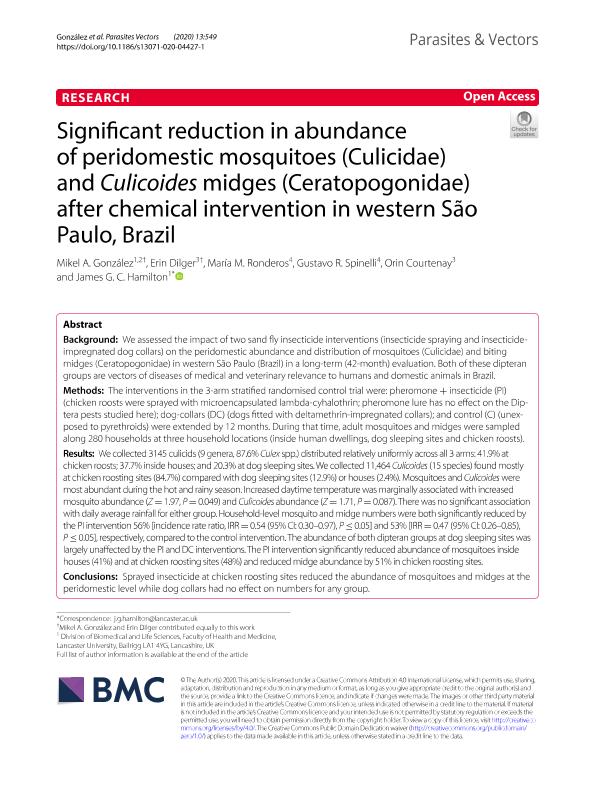Artículo
Significant reduction in abundance of peridomestic mosquitoes (Culicidae) and Culicoides midges (Ceratopogonidae) after chemical intervention in western São Paulo, Brazil
González, Mikel A.; Dilger, Erin; Ronderos, Maria Marcela ; Spinelli, Gustavo Ricardo
; Spinelli, Gustavo Ricardo ; Courtenay, Orin; Hamilton, James G. C.
; Courtenay, Orin; Hamilton, James G. C.
 ; Spinelli, Gustavo Ricardo
; Spinelli, Gustavo Ricardo ; Courtenay, Orin; Hamilton, James G. C.
; Courtenay, Orin; Hamilton, James G. C.
Fecha de publicación:
07/11/2020
Editorial:
BioMed Central
Revista:
Parasites and Vectors
ISSN:
1756-3305
Idioma:
Inglés
Tipo de recurso:
Artículo publicado
Clasificación temática:
Resumen
Background: We assessed the impact of two sand fly insecticide interventions (insecticide spraying and insecticide-impregnated dog collars) on the peridomestic abundance and distribution of mosquitoes (Culicidae) and biting midges (Ceratopogonidae) in western São Paulo (Brazil) in a long-term (42-month) evaluation. Both of these dipteran groups are vectors of diseases of medical and veterinary relevance to humans and domestic animals in Brazil. Methods: The interventions in the 3-arm stratified randomised control trial were: pheromone + insecticide (PI) (chicken roosts were sprayed with microencapsulated lambda-cyhalothrin; pheromone lure has no effect on the Diptera pests studied here); dog-collars (DC) (dogs fitted with deltamethrin-impregnated collars); and control (C) (unexposed to pyrethroids) were extended by 12 months. During that time, adult mosquitoes and midges were sampled along 280 households at three household locations (inside human dwellings, dog sleeping sites and chicken roosts). Results: We collected 3145 culicids (9 genera, 87.6% Culex spp.) distributed relatively uniformly across all 3 arms: 41.9% at chicken roosts; 37.7% inside houses; and 20.3% at dog sleeping sites. We collected 11,464 Culicoides (15 species) found mostly at chicken roosting sites (84.7%) compared with dog sleeping sites (12.9%) or houses (2.4%). Mosquitoes and Culicoides were most abundant during the hot and rainy season. Increased daytime temperature was marginally associated with increased mosquito abundance (Z = 1.97, P = 0.049) and Culicoides abundance (Z = 1.71, P = 0.087). There was no significant association with daily average rainfall for either group. Household-level mosquito and midge numbers were both significantly reduced by the PI intervention 56% [incidence rate ratio, IRR = 0.54 (95% CI: 0.30–0.97), P ≤ 0.05] and 53% [IRR = 0.47 (95% CI: 0.26–0.85), P ≤ 0.05], respectively, compared to the control intervention. The abundance of both dipteran groups at dog sleeping sites was largely unaffected by the PI and DC interventions. The PI intervention significantly reduced abundance of mosquitoes inside houses (41%) and at chicken roosting sites (48%) and reduced midge abundance by 51% in chicken roosting sites. Conclusions: Sprayed insecticide at chicken roosting sites reduced the abundance of mosquitoes and midges at the peridomestic level while dog collars had no effect on numbers for any group.[Figure not available: see fulltext.].
Archivos asociados
Licencia
Identificadores
Colecciones
Articulos(CEPAVE)
Articulos de CENTRO DE EST.PARASITOL.Y DE VECTORES (I)
Articulos de CENTRO DE EST.PARASITOL.Y DE VECTORES (I)
Citación
González, Mikel A.; Dilger, Erin; Ronderos, Maria Marcela; Spinelli, Gustavo Ricardo; Courtenay, Orin; et al.; Significant reduction in abundance of peridomestic mosquitoes (Culicidae) and Culicoides midges (Ceratopogonidae) after chemical intervention in western São Paulo, Brazil; BioMed Central; Parasites and Vectors; 13; 1; 07-11-2020; 1-13
Compartir
Altmétricas



